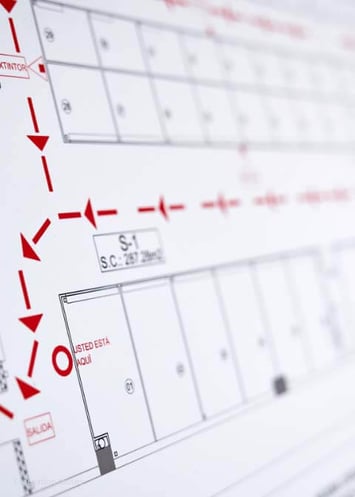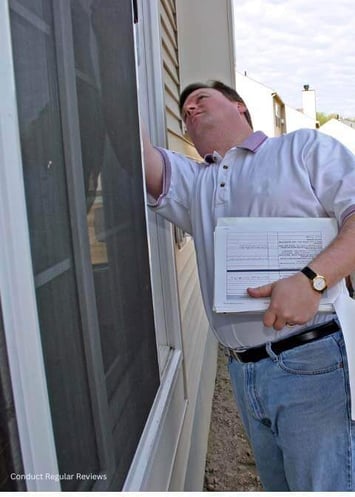By Jay Palter | August 15, 2024
Agood emergency plan should guide every part of your company’s response when disaster strikes. All of those parts need to work together like a well-oiled machine to ensure the safety of your people, property, and finances.
You’ve probably heard that muster points are critical to your emergency plan. But what are emergency muster points, exactly? How do you choose a good one? How do they fit into the rest of your company’s emergency plan?
We’re going to answer all of those questions and more.
Muster Point Definition
A muster point is the location where personnel evacuate in the event of an emergency. If a workplace is large or complex, multiple muster points should be distributed around its perimeter. This will ensure everyone inside has a safe area they can reach quickly during an emergency.
Determining the proper locations and layouts for these safe areas will save lives when an emergency strikes. Having more staff safe, injury-free, and ready to return to work will, in turn, enable your business to restore normal operations as fast as possible.
Five Qualities of a Good Emergency Muster Point
Your goal in selecting your workplace’s muster points is to provide them with safe locations they can reach quickly and easily. You should look for these five qualities in your emergency muster point locations to best achieve that goal:
1. Safe Surroundings
Despite all the emergency response planning you do, staff will still be anxious and not thinking clearly when they evacuate. You want to select muster point locations that will be free of potential hazards, such as downed power lines, during emergencies.
Make sure your muster points will be safe in all conditions. For example, if you’re on a flood plain, even if you’re not near a waterway, select muster points that are on high ground.
2. Safe Distance
Emergency muster points need to be located a safe distance from your work site. A good rule of thumb is to place muster points at a distance of at least one-and-a-half times the height of your tallest structure. This will keep evacuated personnel at a safe distance from any fire or flying debris and give first responders room to operate next to your buildings safely.
3. Appropriate Amount of Space
You need to designate muster points large enough to accommodate your entire workforce. Assign locations that can safely accommodate all personnel, contractors, and visitors. If you’re designing an evacuation plan for a larger facility, you may want to distribute muster points around your perimeter to keep evacuation times low from all locations.
4. Accessible to Everyone
Muster points must be accessible—and that means to everyone. Muster points need to be accessible to those with a physical disability, as well as to older personnel and those in poorer health. For example, don’t select a muster point requiring a long uphill climb.
It doesn’t matter whether anyone is currently on staff with those characteristics. Your muster points still need to be accessible to everyone—including contractors and unplanned visitors—when an emergency strikes.
5. Access to Supplies & Emergency Response Assets
In an emergency, having supplies like first aid kits, flashlights, fire extinguishers, emergency communication devices, facility keys, and defibrillators is critical for managing the situation while waiting for first responders. Proper PPE and medical supplies tracking ensures those assets remain available and usable when they’re needed most.
The muster point should be strategically located near these assets or have a dedicated storage system where they can be securely kept and easily accessed during an emergency while maintaining reliable unauthorized access prevention when they’re not in use.
Do I Need Emergency Muster Points?
According to FEMA, fire and flood are the most common causes of evacuations. But depending on local factors, you may also need to prepare for events such as:
- Hurricanes
- Tornados
- Earthquakes
- Explosions
- Hazardous waste spills
- Civil unrest
- Workplace violence
Every organization is at risk for some combination of these natural and man-made emergencies. All require orderly, efficient evacuations to save lives, and designating muster points is one of the best ways to ensure that happens.
Setting muster points in advance ensures staff always knows where to seek safety in an emergency. It also reduces unnecessary decision-making about where to go during emergencies so that personnel can reach safety faster. Establishing muster points also facilitates headcounts, or roll calls, which provide first responders with a better understanding of who is safe and who is still in danger.
Make Sure the Right People Have the Right Keys—Fast
A well-defined muster point is only effective if your team can access the tools they need in an emergency. KeyTracer electronic key cabinets ensure fast, secure access to fleet keys, facility doors, and emergency equipment—while keeping full accountability at all times.
How to Integrate Emergency Mustering into Your Safety & Security Plan
Integrating your mustering process into your overall emergency action plan (EAP) will improve the effectiveness of emergency mustering.
Here are a few steps you can take to improve that integration:
Assign Emergency Managers
Evacuations shouldn’t be a disorganized race out of your facility. Set clear roles and responsibilities for each essential task that needs to be completed during an evacuation. You will want to assign one or more emergency managers for each department or floor within your workplace.
Emergency managers perform several different functions during an emergency:
- They check assigned floors or buildings to confirm staff have evacuated.
- They supervise the shutdown of critical infrastructure.
- They take roll calls at muster points.
- They coordinate with first responders.
Emergency managers will report to your company’s emergency response coordinator during drills and actual emergencies. This could be the company’s health and safety officer, security director, or another experienced individual. This clear chain of command will improve decision-making and response times.

Designate a Communication Center
Your assigned response team must communicate effectively. Designate an emergency communication center where your response coordinator will operate. This communication center could be established at one of your assigned muster points or a different safe location. Ensure personnel at this location have access to essential assets, mobile devices for communication and coordination, and keys to your facility to allow first responders the access they need. You need reliable methods for safety gear tracking, too.

Document the Entire Process
You will receive alerts for some natural disasters, like storms and floods. However, most emergencies businesses will encounter occur with no notice. That means you need to take the time to document every essential component of your mustering process and asset management during emergencies before disaster strikes.
Document your assigned emergency managers, roles, and chain of command. Document muster point locations. If you need to identify different muster points for different types of emergencies, these must be recorded in your EAP.
Evacuation routes should both be documented and clearly labeled. Contingencies for worst-case scenarios need to be considered, too. For example, brainstorm your response if there is no power throughout your facility.

Be Flexible
Although emergency responses require a clear chain of command, employees still need to be able to react independently when an emergency occurs. Your EAP needs to be flexible and responsive to the fact that workplaces are dynamic settings that change hourly during the workday.
Your plan shouldn’t be designed under the assumption that staff will always be in their one assigned location. For example, they might need to fill in another team or step away from their work on the production floor to do paperwork in the back office. Evacuation procedures must be effective no matter where someone is in your facility.
Evacuation routes must be simple and appropriately labeled for staff caught in an unfamiliar part of your facility. Muster points need to be large enough to accommodate changes in capacity.

Train, Train, and Train Again
Develop a regular schedule for your company’s emergency preparedness training. Conduct evacuation drills at least annually. Drills help staff familiarize themselves with evacuation procedures, making them more decisive in a crisis.
Drills also help emergency managers and first responders identify potential problems with your evacuation plan before an actual emergency strikes. For example, emergency managers for two adjacent floors might each have assumed the other was checking an in-between mezzanine level for stragglers. Or representatives from the fire department may point out that ambulances won’t be able to reach certain muster points you thought were accessible.

Conduct Regular Reviews
Your environment will change. Buildings will be renovated, outdoor spaces redesigned, and neighboring buildings will change ownership. In addition to regular training, you also need to review your evacuation plan regularly to account for these potential changes.
You should account for whole new types of threats. For example, if your business is located in an industrial park, did a new business move in next door that works with hazardous materials you haven’t had to deal with before? Do you need to develop a new response plan for nearby chemical spills?
Reviewing environmental changes is especially important in urban and suburban locations where such changes are common. In a city center, a company’s muster points likely need to be on public property or adjacent private property. Do you need approval from a new neighbor to use their property during evacuations? Did the city unexpectedly plant trees in the middle of one of your public space muster points?

Adding Smart Lockers for Emergency Management is a Game-Changer
Smart technology is revolutionizing business sectors, from healthcare to heavy industry and emergency services. Using smart lockers for emergency management can significantly enhance safety, efficiency, and preparedness.
A smart asset-tracking system is critical during emergencies. It ensures that all essential items—such as first aid kits, medical supplies, PPE, emergency communication devices, critical documents, safety gear, hazardous materials, and crucial IT equipment—are accounted for, easily accessible, and secure. This technology allows for real-time monitoring and critical asset management of these vital resources, reducing the risk of misplacement or loss when needed.
Moreover, smart key management ensures that keys to vital areas—such as emergency exits or safe zones—are readily available, preventing any delays that could jeopardize safety. It also helps maintain security by controlling access to restricted areas, even amidst the chaos of an emergency. By integrating smart tech into your emergency response strategy, you improve asset security and streamline critical processes, ensuring that your organization is prepared for any situation.

Intelligent Lockers: More Than Just Emergency Management – Solve Your Biggest Operational Challenges
Discover the Power of Intellignet Lockers and See How They Can Transform Your Business Operations.
Subscribe to our blog

Jay Palter
Vice President of Marketing & Partnerships




